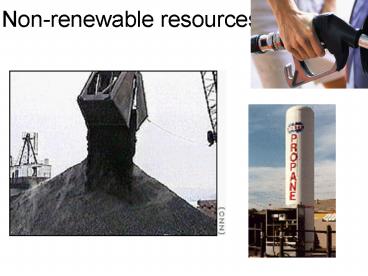Nonrenewable resources - PowerPoint PPT Presentation
1 / 42
Title:
Nonrenewable resources
Description:
Intermountain and Mohave coal plants are considered in ... Ca released from synthetic gypsum (piled in field above) can prevent soil crusting seen above. ... – PowerPoint PPT presentation
Number of Views:584
Avg rating:3.0/5.0
Title: Nonrenewable resources
1
Non-renewable resources
2
Nonrenewable Resources and Production of
Electricity in U.S.
3
California Energy Sources for Electricity
Electricity (2005) In state 78.33 Natural
Gas 37.71 Nuclear 14.47 Large
Hydro 17.03 Coal 20.07 Intermountain and
Mohave coal plants are considered in-state
because they are in CA control areas.
Renewable 10.73 Imports 21.67
4
Average sources of energy used to meet US summer
needsDOE http//www.eia.doe.gov/cneaf/electricit
y/epa/figes2.html
5
What is Electricity?http//www.safeelectricity.or
g/esw_v1_1/science/basics.htm
Electricity is the flow of electrons generated by
a Turbine which is basically a shaft with blades
at one end and electromagnets at the other. Water
or steam or some other energy source pushes the
blades, which make the shaft and the magnets spin
very fast. The magnet end is surrounded by heavy
coils of copper wire, and the spinning magnets
cause electrons in the wire to begin to move,
creating the flow of electrons we call
electricity.
6
COAL
7
Electricity from Coal Burning
8
Coal Burning plants in California
9
What are CCPs? Coal Combustion Productsfootnote
The DOE calls CCPs CUBs Coal Utilization
Byproducts
10
Compostion of Sample of Fly Ash
11
Environmental Impact/Mitigation of CCP's
Ca released from synthetic gypsum (piled in
field above) can prevent soil crusting seen above.
Recycling Fly Ash and other CUB's (Coal
Utilization Byproducts)
12
Utilization of CCPs
13
Fly Ash Recycled into Concrete
14
Why do we care about concrete? Because it is made
from
15
Why replacing cement with Fly Ash is a very good
idea!
- Four essential elements are needed to make
cement Calcium, Silicon, Aluminum and Iron.
(look familiar?) - Calcium (which is the main ingredient) can be
obtained from limestone, - Silicon can be obtained from sand and/or clay.
- Aluminum can be extracted from bauxite
- Iron from iron ore, and only small amounts are
needed.
16
Reduction goals of greenhouse gas emissions from
concrete production. Each ton of fly ash that
replaces cement in concrete production reduces
greenhouse gas emissions by a ton of carbon
equivalents. In 2002, the use of fly ash in
concrete reduced emissions by over 12.5 million
tons of carbon equivalents.(www.epa.gov/epaoswer/
0sw/conserve/c2p2/about/results.htm)
17
Synthetic Gypsum made from CCPs
What is gypsum? gt95 CaS04 Al, O, Si, F
18
From Coal to Gypsum
19
Mercury Pollution
Mercury is a harmful neurotoxin that has been
found to stall the development of children's
brains, both in and out of the womb. Every year
630,000 babies are born in America with unsafe
levels of mercury in their blood. More than 40
states have issued fish advisories due to mercury
contamination in some or all their state's
waters.Coal-burning electric power plants emit
vast quantities of toxic air pollution not only
have they been found to be the largest
unregulated source of mercury pollution, but they
also emit more than 80 tons per year of lead, and
more than 70 tons per year of arsenic. From
EPA New Mercury Rules Under Fire http//health.da
ilynewscentral.com/content/view/514/62
20
Mercury in our Environment
21
Biological removal of mercury from coal
- Iron and sulfur eating bacteria have previously
been used for sulfur removal from coal and for
mineral mining. - The removal of mercury from coal is also possible
via the same principles. Two bacteria,
Leptospirillum ferrooxidans and Acidithiobacillus
ferrooxidans and four environmental bacterial
samples obtained from acid mine drainage were
studied for mercury removal from coal. - Four different coal samples were included in the
study preliminary results have shown that up to
20 of the mercury can be removed in batch
cultures compared to control.
22
Largest Coal producing countries in the world
Which country uses more coal than it produces?
23
Coal Production/Consumption by Region
24
Worldwide Coal Reserves which region has the
greatest amount of high quality bituminous coal?
Sub-bituminous (anthracite) coal? Lignite?
25
Which two countries combined have approximately
50of all of the worlds coal reserves?
26
OIL Where is it?
27
Proven Oil Reserves by Region
28
Where in North America are the major reserves?
29
California Sources of Petroleum and Natural Gas
Petroleum (2005) In state 37.22 Alaska 20.99
Foreign 41.79
Natural Gas (2005) In State 15.0 Canada 23.0
Rockies 24.0 Southwest 38.0
30
http//a4nr.org/articles/CaNukeAerialViews
Californias Remaining Nuclear Power Plants
Diablo Canyon
San Onofre (SONGS)
31
Nuclear Power and the SocioPolitical
LandscapeAre our nuclear power plants safe in
regards to a terroist attack?Terroism and
Nuclear Energy
32
Environmental Impacts Thermal and Radioactive
Pollution
Train derailment, Lincoln Co., Nevada
Thermal pollution, Biscayne Bay, Florida
33
Thermal Pollution comes from both fossil fuel and
nuclear power generation. At Turkey point, the
fossil fuel units require 1,270 cfs of cooling
water and raise the water temp. by 12ºF the
nuclear unit requires 4,250 cfs and raises the
water temperature 16ºF.
A solution for the Turkey Point area of Biscayne
Bay 10 sq. mile canals cooling radiators for
water heated by the nuclear power plant. This
water will then be recycled.
34
Radioactive Pollution
35
Nuclear Waste
- The chart below shows sources of nuclear waste in
the UK.
36
http//www.pollutionissues.com/Pl-Re/Radioactive-W
aste.html
37
Electric Power Poll ution Calculator
38
Renewable Energy Resources
39
Biomasshttp//www.riley-reka.co.uk/biomass.htm
40
Potential wave energy kW/m front wave
41
Wave Power!
42
Coupling Renewable Energy Sources with
acquisition of water Projects to filter out
pollutants from fresh water include this
solar-powered "disinfection" system on pontoons
in a Brazilian lake.































